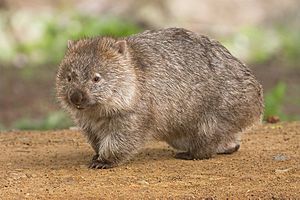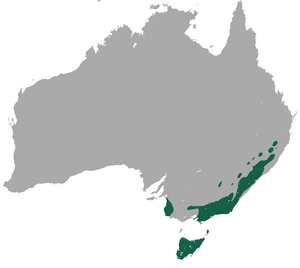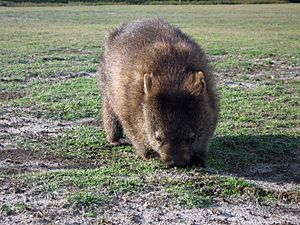Common wombat facts for kids
Quick facts for kids Common wombat |
|
|---|---|
 |
|
| Vombat ursinus tasmaniensis, Maria Island, Tasmania | |
| Conservation status | |
| Scientific classification | |
| Kingdom: | |
| Phylum: | |
| Class: | |
| Infraclass: | |
| Order: | |
| Family: | |
| Genus: |
Vombatus
É. Geoffroy, 1803
|
| Species: |
V. ursinus
|
| Binomial name | |
| Vombatus ursinus (Shaw, 1800)
|
|
 |
|
| Common wombat range | |
The common wombat (Vombatus ursinus) is a type of marsupial. It is also known as the coarse-haired wombat or bare-nosed wombat. This animal is one of three kinds of wombats alive today. It is the only species in its genus called Vombatus. Common wombats usually grow to about 98 cm (38.6 in) long. They can weigh around 26 kg (57.3 lb).
Contents
What is a Common Wombat?
Common wombats are sturdy animals. They are built close to the ground. When fully grown, they can be between 80 and 130 cm (31.5 and 51.2 in) long. They can weigh from 17 to 40 kg (37.5 to 88.2 lb). Wombats found on Tasmania and Flinders Island are often smaller. You can tell them apart from other wombats by their bare nose.
Where Do Wombats Live?

Common wombats live in the cooler, wetter parts of southern and eastern Australia. This includes Tasmania. They are also found in mountain areas as far north as southern Queensland. However, their numbers are going down in western Victoria and South Australia.
You can find common wombats at any height in the south of Australia. But in the north, they only live in higher, mountainous places. They can live in many different homes. These include rainforests, eucalyptus forests, woodlands, and grassy alpine areas. They also live near the coast. Some wombats have even learned to live on farms. They can be seen eating grass in open fields with cows and sheep.
Wombat Behaviour
Common wombats are animals that like to be alone. They are also very territorial. This means each wombat has its own area where it lives and finds food. In their area, they dig a system of tunnels. These tunnels can be from 2 to 20 meters (6.6 to 65.6 ft) long. They also have many side tunnels. Usually, there is only one main entrance to their burrow. But they might make a smaller one to escape if needed. Wombats are often active at night. However, they might come out during the day when the weather is cooler. This often happens in the early morning or late afternoon.
What Do Wombats Eat?
Common wombats are herbivores. This means they only eat plants. They mostly eat grass, snow tussocks, and other plant materials. They usually look for food during the night.
How Do Wombats Have Babies?
A common wombat can have babies every two years. They usually have one baby, called a joey. The mother carries the joey for about 20 to 30 days before it is born. After birth, the young joey stays in its mother's pouch for five months. When the joey leaves the pouch, it weighs between 3.5 and 6.5 kg (7.7 and 14.3 lb). The joey stops drinking milk around 12 to 15 months old. It is usually able to live on its own by 18 months of age. Wombats typically live for about 15 years in the wild. They can live up to 20 years if they are cared for by humans.
Images for kids
-
A wombat grazing in Maria Island, Australia
See also
 In Spanish: Uómbat común para niños
In Spanish: Uómbat común para niños




